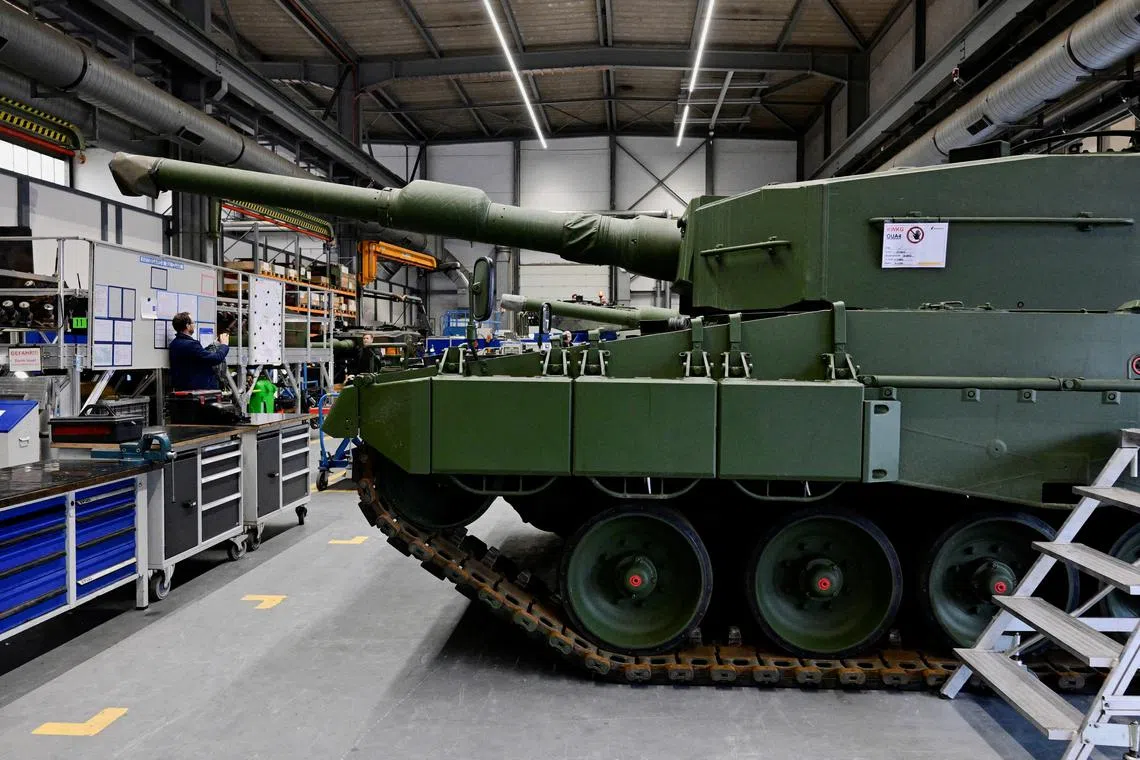Tanks, not cars: How a pivot to defence could help Germany’s economy
Sign up now: Get ST's newsletters delivered to your inbox

A view of a production line where weapons maker Rheinmetall plans to produce artilleries from 2025 in Unterluess, Germany.
PHOTO: REUTERS
Follow topic:
FRANKFURT - German defence companies seeking more capacity as Europe prepares to raise military spending are eyeing the ailing car industry, the first sign of a shift that could help revive the continent’s biggest economy after two years of contraction.
Manufacturers of tanks, radar and weapons are aiming to ramp up production as Europe responds to US pressure to take care of its own defences.
Carmakers, for decades Germany’s economic powerhouse, are meanwhile cutting jobs and shutting plants amid slowing demand and a creaking electric vehicle transition
Rheinmetall, Europe’s top ammunition maker, said last week it would repurpose two plants currently turning out automotive parts to mostly make defence equipment.
Hensoldt, which makes the TRML-4D radar systems being used by Ukraine in its war with Russia, is in talks to take on around 200 workers from major auto parts suppliers Bosch and Continental.
“We are benefiting from the difficulties in the automotive industry,” Hensoldt’s chief executive Oliver Doerre told Reuters, adding that further investment could more than double annual production of the TRML-4D to between 25 and 30.
On March 2, European leaders agreed they must spend more on their militaries at an emergency summit in London convened after a public clash between presidents Donald Trump and Volodymyr Zelensky
EU leaders are scheduled to meet on March 6 to discuss proposals to mobilise up to €800 billion (S$1.1 trillion) for rearmament, including €150 billion of joint borrowing.
Separately, the parties in talks to form Germany’s new government late on March 4 announced proposals to set up a €500 billion fund for infrastructure and overhaul borrowing rules in order to massively up defence spending.
As a result, European defence stocks have rallied sharply this week.
The Bruegel think-tank estimates Europe may need 300,000 additional troops and a short-term annual increase in defence spending of at least €250 billion “to deter Russian aggression”.
GDP boost
A pivot towards defence production could give a boost to the Germany economy, which has become a laggard among European peers as businesses grapple with high energy costs, red tape and aggressive competition from abroad.
The IfW Kiel Institute for the World Economy reckons the European Union’s gross domestic product could grow by 0.9-1.5 per cent a year if EU countries raise military spending to 3.5 per cent of GDP from the current 2 per cent Nato target and rely on local technology.
“In the medium to long term, American economic history in particular has shown that such military spending can deliver a great deal in terms of productivity gains, spillover and technological advances,” IfW Kiel’s Johannes Binder said.
For Germany, with its existing industrial infrastructure, GDP growth would likely be at the upper end of that range, he added.
Raising defence spending to 3 per cent of GDP would more than double Germany's annual investments to €25.5 billion, create 245,000 direct and indirect jobs and trigger nearly 42 billion in production and service activity each year, EY estimates.
The most recent figures available show Germany’s security and defence industry employed 387,000 people in 2022, around half as many as the country’s auto sector that year. Defence industry sales totalled €47 billion in 2022, compared with 506 billion for the car sector.
“We must consider the defence industry as an economic motor for Germany,” said Hensoldt’s Mr Doerre. “The sector will play a more significant role than in the past.”
Hensoldt has already started to outsource production of circuit boards and Mr Doerre said that could eventually be expanded to wire harnesses and casings.
Using spare capacity in the car sector would help preserve Germany's established manufacturing infrastructure as well as boosting the output of military equipment, he noted.
Synergies
Car industry supplier ZF Friedrichshafen, itself in a restructuring process that may result in German plant closures, has been in touch with defence companies about shifting workers, it said, citing “industrial synergies”.
Tank gearbox manufacturer Renk, majority-owned by Volkswagen until 2020, said the automotive sector had become more of a focus recently, especially with regard to the scaling of production capacities. It did not give further details.
German-French military defence system supplier KNDS, which plans to make the Leopard 2 battle tank and the Puma infantry fighting vehicle at a German tram plant it recently agreed to buy from France's Alstom, did not respond to queries.
Analysts at Deutsche Bank warned in a note in February, however, that increased EU defence spending might not bring significant benefits to the local industry, which is more fragmented than its US counterpart.
Former European Central Bank chief Mario Draghi, in a recent report on Europe's competitiveness, said between mid-2022 and mid-2023 nearly four-fifths of the EU's defence procurement spending went to non-EU suppliers.
Rheinmetall is also talking to Continental about taking on around 100 employees to beef up operations.
Its chief executive Armin Papperger told Reuters in February that huge investments in missiles, ammunition and vehicles were needed to make Europe more resilient, adding the continent was way behind target in terms of spending.
“(Russian President Vladimir) Putin knows this too, of course, and that’s why we have to act,” he said. REUTERS

